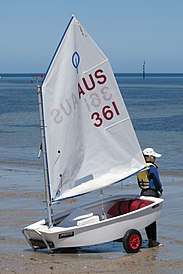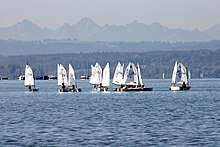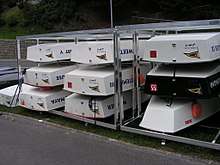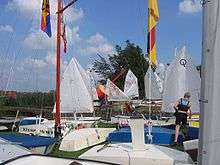Optimist (dinghy)
The Optimist, also known as the ‘opti’, 'oppie', 'opy' or 'bathtub' is a small, single-handed sailing dinghy intended for use by children up to the age of 15. Contemporary boats are usually made of fibreglass, although wooden boats are still built.
 Class symbol | |
 | |
| Development | |
|---|---|
| Location | International |
| Design | One-Design |
| Boat | |
| Crew | 1 |
| Draft | 5 in (130 mm) 2 ft 9 in (0.84 m) |
| Hull | |
| Type | Monohull |
| Construction | Fibreglass |
| Hull weight | 77 lb (35 kg) |
| LOA | 7 ft 9 in (2.36 m) |
| LWL | 7 ft 2 in (2.18 m) |
| Beam | 3 ft 8 in (1.12 m) |
| Hull appendages | |
| Keel/board type | ((daggerboard or centreboard)) |
| Rig | |
| Rig type | Sprit-Rigged |
| Mast length | 7 ft 5 in (2.26 m) |
| Sails | |
| Mainsail area | 35 sq ft (3.3 m2) |
| Jib/genoa area | None |
| Spinnaker area | None |
| Racing | |
| D-PN | 123.6 |
| RYA PN | 1646 |



It is one of the most popular sailing dinghies in the world, with over 150,000 boats officially registered with the class and many more built but never registered.
The Optimist is recognized as an International Class by the International Sailing Federation.
Origin
The Optimist was designed in 1947 by American Clark Mills at the request of the Clearwater Florida Optimist service club following a proposal by Major Clifford McKay to offer low-cost sailing for young people.[1] The Optimist Club ran a soap box derby, but wanted more than a single-day event. Thus they were looking for a low-cost equivalent for sailing.[2] He designed a simple pram that could be built from two 4' x 8' sheets of plywood,[3] and donated the plan to the Optimists. The design was slightly modified and introduced to Europe by Axel Damgaard, and spread outwards across Europe from Scandinavia.[4] The design was standardized in 1960 and became a strict One-Design in 1995.[5] Originally, the Windmill was designed by Clark Mills to be sailed when the sailors became too large or heavy for the Optimist, but the most common boats to transition to are the Laser and C420.[6]
The Optimist is sailed in over 120 countries[7] and it is one of only two yachts approved by the International Sailing Federation exclusively for sailors under 16.[8] Optimists are one of the smallest sailing dinghys. Sailors can continue to race them up to the age limit of 15 years old. Optimists are single handed boats. Many sailing schools and yacht clubs own a number of them and they are the first boat most beginners will sail.
Description
Rig
The single sail of the Optimist is sprit-rigged. Two battens stiffen the leech. It is secured evenly with ties along the luff to the mast and along the foot to the boom, pulled down tightly by a vang/kicker. The light, slim third spar, the sprit, extends through a loop at the peak of the sail; the bottom rests in the eye of a short cable or string which hangs along the front edge of the mast. Raising and lowering the sprit and adjusting the boom vang allow for adaptation of sail trim to a range of wind conditions. Similarly, the Optimist has a small string outhaul on the end of the boom. It is usually correct to tighten the boomvang, outhaul, and sprit in heavy winds and loosen them in light winds. As well as this, huge adjustments can be made to sail shape, due to all of the ties running along the mast and boom.
The spars may be made from aluminium or wood, but are invariably aluminium in modern boats.
A monograph-style "IO" insignia (after IODA - the International Optimist Dinghy Association) on the sail is a registered trade-mark and may only be used under licence from the International Optimist Association. Optimists also have a national sail number using the Olympic abbreviation of their country and a sequential numbers. e.g. RSA for South Africa.
Hull
The Optimist has a pram hull, originally formed primarily from five pieces of plywood. It was the biggest hull Clark Mills could make from two 4 ft by 8 ft sheets. Just in front of a bulkhead, which partitions the boat nearly in half, is the daggerboard case. Right behind it on the centerline of the hull floor are attached a pulley and ratchet block. These anchor the sheet and its pulley on the boom directly above. At the bow resides a thwart to support the mast which passes through a hole in its centre to the mast step mounted on the centre line of the boat. The painter, a rope used for securing a boat like a mooring line, is usually tied around the mast step.
Buoyancy bags are installed inboard along each side in the front half of the boat and at the stern to add buoyancy in the event of capsizing. Two straps, known as "hiking straps", run lengthwise along the floor from bulkhead to stern. These and a tiller extension allow a sailor to hang off the side for weight distribution—commonly called "hiking out". This can be crucial to maintaining the boat in near horizontal disposition during heavy air, allowing greater speed through the water and more manoeuvrability.
The vast majority of hulls today are made of fiberglass,[9] although it is still possible to make and buy wooden hulls.
Foils
The rudder and daggerboard can be made from plywood or a composite of foam, glass fibre, and epoxy.
Performance
While younger lighter sailors begin in Optimists, competitive sailors usually weigh between 35 and 55 kg (or between 80 lbs. and 125 lbs.).[10] Optimists can be sailed by children from age 8 to 15. This wide range of weights which is not typical of most dinghies is made possible by different cuts of sail. Due to its inherent stability, unstayed rig, robust construction and relatively small sail, the Optimist can be sailed in winds of up to 30 knots.
Optimists are manufactured to the same specification by over 20 builders on four continents. There is strong evidence[11] that hulls from different builders are the same speed. Sails and spars of differing qualities enable sailors to upgrade their equipment as they progress.
The Optimist is the slowest dinghy in the world according to the RYA Portsmouth Yardstick scheme, with a Portsmouth number of 1646.[12] Its equivalent rating in the US scheme is a D-PN of 123.6.[13]
Competition
The Optimist is the biggest youth racing class in the world.[14] As well as the annual world championship the class also has six continental championships, attended by a total of over 850 sailors a year.[15] Many of the top world Optimist sailors have become world-class Laser Radial or 4.7 sailors after they "age-out" but many also excel in double-handers such as the 420 and 29er. At the 2016 Olympics at least 85% of the boat skippers were former Optimist sailors.[16]
The first World Championship was held in Great Britain in 1962 and it has grown to over 60 countries participating.[17] The changing pattern of the strongest countries can be seen from the results of the Nations Cup.[18] For the first 20 years, the class was dominated by sailors from the Scandinavian countries, with 13 world champions. In the 1990s Argentina was by far the dominant country but, following standardisation of the boat and improved coaching standards internationally, many countries have excelled. Recently S.E. Asian countries and the United States have produced strong teams. The Optimist World Championships include Team Racing which is increasingly popular.
Continental Championships are held on each continent (the Oceanian held jointly with the Asian). Results can be found at.[19]
Open Events: With competitive charter boats easily available and low-cost airfares, there are scores of open international regattas. The largest is the Lake Garda Easter Meeting[20] with over 1,000 Optimists participating.
Manufacture
In recent years, over 2,200[21][22] boats a year have been produced by around 30 builders worldwide.[23]
Events
World Championship
Year |
Gold | Silver | Bronze |
|---|---|---|---|
| 1962 Great Britain | |||
| 1963 Sweden | |||
| 1964 Denmark | |||
| 1965 Finland | |||
| 1966 Miami | |||
| 1967 Austria | |||
| 1968 France | |||
| 1969 Great Britain | |||
| 1970 Spain | |||
| 1971 Kiel | |||
| 1972 Karlskrona | |||
| 1973 Rhodesia | cancelled | ||
| 1974 St. Moritz/Silvaplana | |||
| 1975 Aarhus | |||
| 1976 Ankara | |||
| 1977 Yarinca | |||
| 1978 La Baule | |||
| 1979 Pattaya | |||
| 1980 Cascais | |||
| 1981 Howth | |||
| 1982 Follonica | |||
| 1983 Rio de Janeiro[24] | |||
| 1984 Kingston | |||
| 1985 Helsinki | |||
| 1986 Roses | |||
| 1987 Andijk | |||
| 1988 La Rochelle | |||
| 1989 Yokohama | |||
| 1990 Portugal | |||
| 1991 Porto Carras | |||
| 1992 Mar del Plata | |||
| 1993 Ciutadella de Menorca | |||
| 1994 Sardinia | |||
| 1995 Mariehamn | |||
| 1996 Langebaan | |||
| 1997 Carrickfergus | |||
| 1998 Setúbal | |||
| 1999 Martinique | |||
| 2000 La Coruña | |||
| 2001 Qingdao | |||
| 2002 Corpus Christi | |||
| 2003 Las Palmas | |||
| 2004 Salinas | |||
| 2005 St. Moritz | |||
| 2006 Montevideo | |||
| 2007 Sardinia | |||
| 2008 Çeşme | |||
| 2009 Niterói[25] | |||
| 2010 Langkawi[26] | |||
| 2011 Napier[27] | |||
| 2012 Boca Chica[28] | |||
| 2013 Riva del Garda[29] | |||
| 2014 San Isidro[30] | |||
| 2015 Dziwnow[31] | |||
| 2016 Vilamoura | |||
| 2017 Pattaya[32] | |||
| 2018 Limassol[33] | |||
| 2019 Antigua[34] | |||
References
- Bird, Vanessa (2013). "Optimist", Classic Classes, A&C Black. ISBN 9781408158906. p.53
- Longstreet, Robert L. (1963). "Operation Optimist - A Community Project", Boating, July–December 1983. p.47.
- Cole, Tim. (1983). "One Design Racing", Yachting, April Edition. p.62.
- McMillan, Roger (2010). "Optimistic Outlook - MySailing.com.au". www.mysailing.com.au. Retrieved 17 July 2017.
- "History behind the one-design". International Optimist Dinghy Association.
- "Windmill Class Association".
- "Optimist World in 2014" (PDF). International Optimist Dinghy Association. 5 February 2015. Retrieved 5 February 2015.
- "ISAF: Optimist". International Sailing Federation. Retrieved 6 December 2009.
- Pickthall, Barr (2009). Dinghy sailing : start to finish. John Wiley & Sons. p. 25. ISBN 9780470721858.
- http://www.wilkessail.net/idealsize.pdf
- http://www.wilkessail.net/ParityBlurbC.pdf
- "Portsmouth Number List 2012". Royal Yachting Association. Retrieved 31 July 2012.
- "Centerboard Classes". US Sailing. Archived from the original on 16 August 2012. Retrieved 31 July 2012.
- "Classes & Equipment Index". sailing.org. Retrieved 8 July 2016.
- http://www.wilkessail.net/REVIEWOF2008.doc
- "Ex-Optimists at 206 Olympics". Retrieved 12 January 2017.
- http://www.wilkessail.net/ParticipationGraph.html
- http://www.wilkessail.net/IODANationsCup.html
- http://www.wilkessail.net/IODAContinentalsArchive.html
- https://www.gardatrentino.it/en/Garda-Meeting-Optimist-Class-sailing-regatta-Riva-del-Garda/
- "Class Annual Report: International Optimist Dinghy Association 2017" (PDF). www.sailing.org.
- "Class Reports - Optimist". sailing.org. Retrieved 13 January 2019.
- "Optimist". optiworld.org. Retrieved 8 July 2016.
- "1983 Optimist World Championship". Optiworld.org. International Optimist Dinghy Association. Archived from the original on 2018-02-11. Retrieved 2018-02-06.
- "2009 Optimist World Championship". Optiworld.org. International Optimist Dinghy Association. Archived from the original on 2018-02-11. Retrieved 2018-02-06.
- "2010 Optimist World Championship". Optiworld.org. International Optimist Dinghy Association. Archived from the original on 2018-02-11. Retrieved 2018-02-06.
- "2011 Optimist World Championship". Optiworld.org. International Optimist Dinghy Association. Archived from the original on 2018-02-11. Retrieved 2018-02-06.
- "2012 Optimist World Championship". Optiworld.org. International Optimist Dinghy Association. Archived from the original on 2018-02-11. Retrieved 2018-02-06.
- "2013 Optimist World Championship". Optiworld.org. International Optimist Dinghy Association. Archived from the original on 2018-02-11. Retrieved 2018-02-06.
- "2014 Optimist World Championship". Optiworld.org. International Optimist Dinghy Association. Archived from the original on 2018-02-11. Retrieved 2018-02-06.
- "2015 Optimist World Championship". Optiworld.org. International Optimist Dinghy Association. Archived from the original on 2018-02-11. Retrieved 2018-02-06.
- "2017 Optimist World Championship" (PDF). Optiworld.org. International Optimist Dinghy Association. Archived (PDF) from the original on 2018-02-07. Retrieved 2018-02-06.
- "2018 Optimist World Championship" (PDF). Optiworld.org. International Optimist Dinghy Association. Archived (PDF) from the original on 2018-10-14. Retrieved 2018-09-05.
- "2019 Optimist World Championship". Optiworld.org. International Optimist Dinghy Association. Retrieved 2019-07-16.
External links
| Wikimedia Commons has media related to Optimist (dinghy). |
- International Optimist Dinghy Association
- International Sailing Federation (ISAF)
- List of National Class Associations